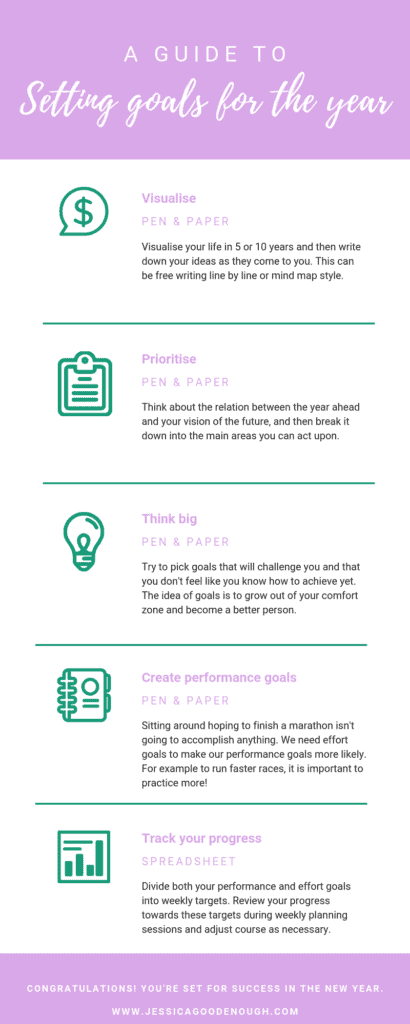Whether you’re reading this in early January or later in the year, it is always a good time to pause and reflect on what you want to achieve this year. It is indeed better to have a plan than to live life on accident! Read on for some advice on how to set goals, with examples from by goals for 2019!
Visualise and prioritise
In order to figure out what do to this year, it is worth thinking of the bigger picture. Like all personal development exercises, it is best to do this with pen and paper rather than in your head. Visualise your life in 5 or 10 years and then write down your ideas as they come to you. This can be free writing line by line or mind map style.
Based on this, you can start thinking about what you can do this year to get there. For example if you want to own a house in a few years’ time, when you might be thinking about starting a family, you could start by creating an income goal for this year.
Think about this relation between the year ahead and your vision of the future, and then break it down into the main areas you can act upon. The idea of agency is important here: only having goals that sit outside your control or revolve around other people will lead to frustration.
For example the main areas of my goals are: my health/fitness, my research work and my income. Once you’ve identified these areas for yourself, you can move into setting targets for the year ahead.
Think big
Common advice is to set “S.M.A.R.T. goals“, with the R standing for realistic. However realistic goals won’t push you, get you out of bed in the morning or help you evolve into a better person. Try to pick goals that will challenge you and that you don’t feel like you know how to achieve yet.
Your mind will push back and try to force you to settle for something easier. But the idea of goals is to grow out of your comfort zone and become a better person. So dare to dream of marathons and successful side hustles!
My health goal is to get five personal bests this year. This involves running a 5K, 10K and half-marathon race faster than I ever have, but also trying something new: finishing a marathon and an ultra-marathon, eek! My research goal involves getting two papers accepted for publication in scientific journals and my income goal is to earn £30,000 this year.
All of these are definitely a stretch for me and I’m doubting myself even now while I write this, but that is the point! To help with the “dauntingness” of big goals, it is key to create effort goals.
Create effort goals to go with your performance goals
Sitting around hoping to finish a marathon isn’t going to accomplish anything. We need effort goals to make our performance goals more likely. To run faster races, it is important to practice more! So my health effort goals are to run 1,000 miles in 2019 and to cover 2,019 miles total (running, walking and cycling).
My research effort goal involves sending twelve drafts (either to my PhD supervisors or to the NGO I’m writing articles for). And my income effort goal is to write 52 blog posts.
It could be easy to get overwhelmed, especially if you have several goals, or to lose steam after the first few weeks. Therefore it is key to have systems in place to make your goals happen.
[You may also like: Setting goals for the year ahead: my blueprint so you can too!]
Stay on track by tracking your achievement towards your goals
As you may have noticed, the goals I have set for 2019 are all measurable. This means that – as opposed to vague goals like “lose weight” or “be more productive” – I will know whether or not I reach them.
It also enables me to track my progress towards them in a spreadsheet. I divided both my performance and effort goals into weekly targets. I will review my progress towards these targets during my weekly planning sessions on Sundays, and adjust course as necessary.
Helpful advice I got from the Perfectionism Project podcast is that progress towards yearly goals doesn’t have to be divided into equal quarters. I would recommend setting lower targets at the start of the year, to get momentum going, and larger ones at the end. For me, this looked like dividing the goal by two every quarter, counting backwards from the end of the year.
So for my goal to run 1,000 miles this year, I have set a target of 500 miles by the end of September, 250 by the end of June and 125 by the end of March. Having approachable goals at the start of the year will enable me to start ticking things off and encourage me to keep moving on my goals.
Voilà, there you have it: this is how I’m setting goals for 2019 in a way that will increase my chances of success. If you found this useful, please:
- Share your goals and goal-setting process in the comments section below;
- Send this post to a friend/relative you think might appreciate it or share it on social media;
- Give me a small tip on Ko-fi – it would be very appreciated!




![Only a month late... Here are our Valentine's Day photos! 👩🏼❤️💋👨🏻😅
We've been on a bit of a Caribbean kick (say that 10 times!) since watching the One Love film about Bob Marley on Valentine's Day + @gazoakley's adventures in Jamaica on the YouTubezz. 🇯🇲
So far we've eaten at @turtlebayuk [apologies for the blurry photos, I took them before getting my new @fairphone!] and ordered from Pappy's Afro Caribbean Takeaway (don't think they're on Instagram)... Next step is to make it at home; any recipe recommendations? 😘
#PlantBased #JamaicanFood #CaribbeanFood #OneLove](https://jessicagoodenough.com/wp-content/plugins/instagram-feed/img/placeholder.png)
Leave a Reply
You must be logged in to post a comment.